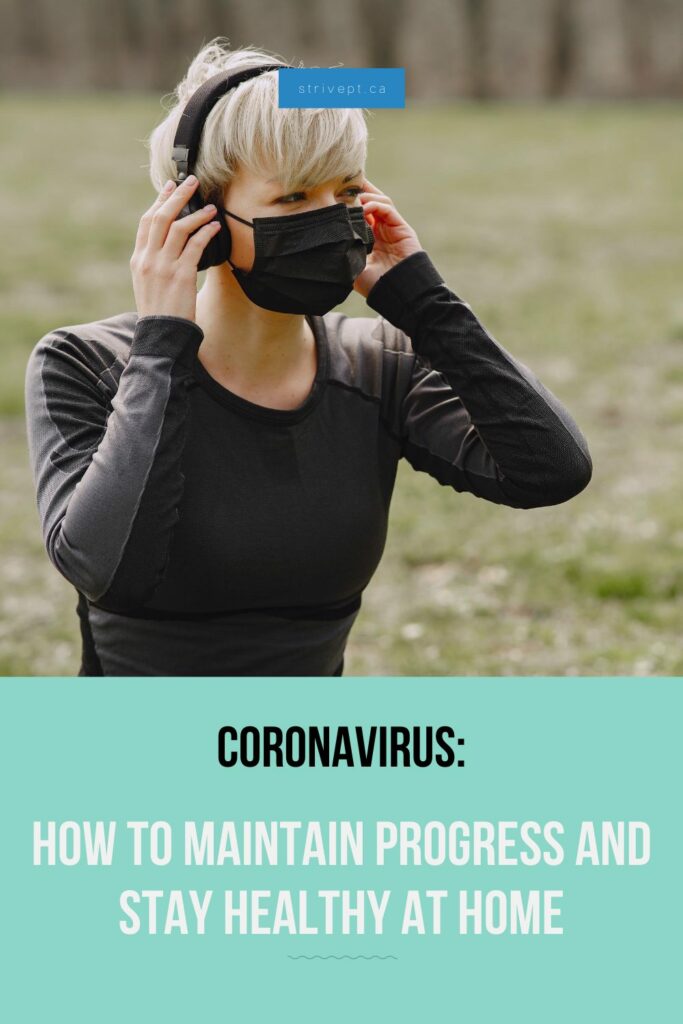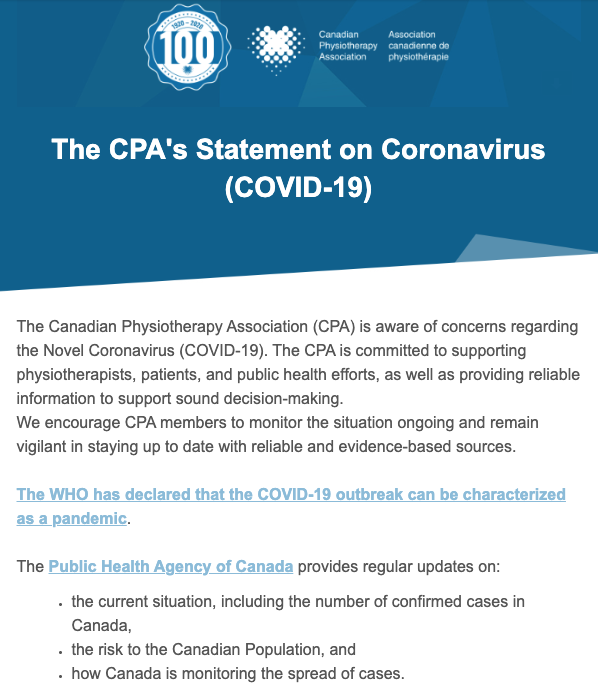
On March 11th, 2020; the World Health Organization (WHO) officially declared the Coronavirus (COVID-19) an international pandemic. As instances of COVID-19 continue to spread across the planet, it is important to know what you can do to protect yourself, and your loved ones.
As physiotherapists helping people manage pain and injury, it is our responsibility to help people make progress given all individualized circumstances. The recent COVID-19 outbreak is just an (albeit, new and very serious) individual circumstance. This blog aims to provide advice on what you can do to stay healthy, while also progressing through your rehabilitation, even if you have to do it alone at home.
First and foremost, it is HIGHLY encouraged that you gather information about COVID-19 ONLY from REPUTABLE resources. These include:
In the world of social media, you will hear and read about the COVID-19 virus multiple times per day. Ensure that the information you are choosing to believe is based on the BEST current evidence from the MOST REPUTABLE sources.
Staying Healthy at Home During Coronavirus
In general, it is important to take every day precautions with respect to the COVID-19 virus. This is due to the fact that the virus is highly contagious. The World Health Organization has released the following guidelines to help everyone remain vigilant (SOURCE: https://www.who.int/emergencies/diseases/novel-coronavirus-2019/advice-for-public):
- Regularly wash your hands
- Use alcohol based sanitizer or soap and water – this can kill the virus on your hands
- Maintain social distancing
- Stay at least 1 metre away from anyone who is coughing or sneezing – this can prevent you from inhaling droplets containing the virus
- Avoid touching your eyes, mouth, or nose
- Your hands may have come in contact with the virus, and if they have, touching your eyes, mouth, nose, or face increases the chances of the virus entering your body
- Cover your mouth when you cough or sneeze
- Use your elbow/sleeve, or a kleenex. Discard the kleenex immediately. If you use your hands to cover your mouth, wash your hands immediately with alcohol based sanitizer or soap and water. This can help prevent the spread of the virus to other people or surfaces.
- Seek medical care immediately if you have a fever, cough, and difficulty breathing
- Follow the directions of your local health authority (for example: they may want you to call vs. showing up at their office/the hospital)
- National and local medical authorities will have the most up to date information for your area and can best direct you to the most appropriate care
- Limit your attendance to areas with large crowds or high volumes of people, and refrain from shaking hands with others
- These are additional precautionary measures that can help slow the spread of the COVID-19 virus.
Exercising at Home
As mentioned in the 6th point above, avoiding areas with high volumes of people is a simple way to slow the spread of the COVID-19 virus. Therefore, a simple precaution would be to avoid going to the gym, or your exercises classes, instead opting for a home workout. Furthermore, if you’re experiencing symptoms of any kind (i.e. fever, cough, difficulty breathing) it is best to remain in self-isolation at home for 14+ days.
If you’re currently recovering from an injury, or participating in a rehabilitation programme, there are many options for maintaining/progressing your fitness at home. Read on for further advice.
General Workout Advice:
- Workout at home. Avoid the gym. This can help limit the spread of COVID-19.
- Wash your hands before, after, and sometimes during your workout – this will keep your exercise equipment and general area clean.
- Don’t touch your face without washing your hands first – this includes wiping sweat from your face
- Avoid extreme endurance type exercises, as this ‘may’ lower your immune system
- Keep exercising! Providing you are not currently infected, or ill; it is important to continue with a consistent exercise programme. Exercise has been shown to strengthen the immune system and can help fight infections/viruses!
Tips and Tricks for Making Home Workouts Effective
Many people feel they must go to the gym because they need the equipment and weights in order to get a “good” workout. However, there are a lot of at home options for getting a great workout in, and you already have all the equipment you need!
Tip #1: Challenge yourself with body weight exercises
Give this body-weight only workout ladder a try (if you’re uninjured!):
| 9. Jumping jacks – 30 seconds |
Do this ladder as fast as you can, and I promise you’ll feel like you worked out! Your body is an excellent exercise tool, and there are a plethora of body weight exercises that you can use to get in a great workout!
Other body weight exercise examples include: pull ups, step ups, lunges, squat jumps, single leg deadlifts (and many more!)
Tip #2: Use inexpensive exercise bands, or everyday objects as resistance
If you don’t have any specific dumbbells or barbells at home to do weight training with, you can use inexpensive exercise bands, or everyday objects and create enough resistance to get a good burn! Here’s an example of an upper body workout using exercise bands and everyday objects:
- Lateral shoulder raises with exercise bands, 3 sets of 10 reps
- Front shoulder raises with exercise bands, 3 sets of 10 reps
- Chest flys with full laundry detergent jugs as weight – 3 sets of 10 reps
- Bent over rows with full laundry detergent jugs as weight – 3 sets of 10 reps
- Bicep curls with exercise bands (or a bag full of books) – 3 sets of 10 reps
- Tricep dips on the stairs – 3 sets of 10 reps
See! You don’t really need anything complicated to still get in a good workout without going to the gym! An entire set of exercise bands (see here) cost less than 1 month worth of gym membership (at most gyms)!
Other excellent examples of everyday objects that can be used as weights: bag of potatoes, water softener salt, or cans of soup/veggies (multiple in a bag for more weight). You could even do pull ups on your kid’s backyard playset!
Tip #3: Follow along with an exercise video
The internet is a magical thing. It is absolutely filled with FREE, full length, home exercise videos that require little to no equipment. Enter “At Home Workout” on YouTube and you’ll see what I mean! Some people get concerned that the videos they find on the internet would not be safe, and that’s a valid concern. I typically steer people towards this website: www.fitnessblender.com . As a physiotherapist, I have completed hundreds of FitnessBlender workouts, and they’re great! They have videos for beginner and advanced exercisers, as well as a library of over 500 FREE videos that are easily filtered to fit your situation (see: https://www.fitnessblender.com/videos). For example, you can filter the 500+ videos to only show ‘cardiovascular’ workouts that use ‘no equipment’, and take ‘20-30 minutes’ (you’d only have 62 to choose from!). If you also selected a 2/5 difficulty level (beginner), you still have 5 options!
Tip #4: Talk to your physiotherapist!
If you’re rehabbing a particular injury, under the guidance of a physiotherapist, and you’re not sure how to modify your exercises to make them safe and applicable to a home workout environment, just give them a call! Physiotherapists are well versed in all forms of exercise, and are trained to modify exercises to each individual case/situation. They’ll be able to show you/tell you what you can do to ensure your continued progress. Just ask!
If you’re experiencing illness or any of the above listed symptoms, DO NOT ATTEND your physiotherapy appointments. We certainly wouldn’t charge you a cancellation fee (in fact, we never do); and I certainly home whichever rehabilitation clinic you normally attend wouldn’t either.
Tip #5: If you’re sick, or under self-isolation due to illness, just REST!
If you happen to become infected with the COVID-19 virus, or come in contact with someone who may have passed it to you, you may be advised to self-isolate in your home. This will help to limit the possibility of spreading the virus further. So, if you’re ill, just REST! Current understanding from the World Health Organization is that the virus will affect you for 5-14 days. Rome wasn’t built in a day, and much the way you can’t make astronomically significant muscular or cardiovascular gains in 2 weeks, you also can’t have astronomically significant losses in 2 weeks either. Focus on your recovery, and let exercise take a back seat while you heal. This will allow you to get back to exercising, rehabilitation, and recovery from injury much sooner!
Tip #6: Jam out to some great tunes to keep you moving!
We have our own Spotify playlist for working out! If you are thinking maybe you need to change up your music, give it a try!
Conclusion
- Don’t panic.
- Wash your hands, and avoid touching your face.
- Help slow the spread and the strain on our healthcare system.
- Isolate yourself more than usual. Workout at home.
- Seek reputable medical advice.
- Be considerate to others. We’re all in this together.
- WASH YOUR HANDS.
